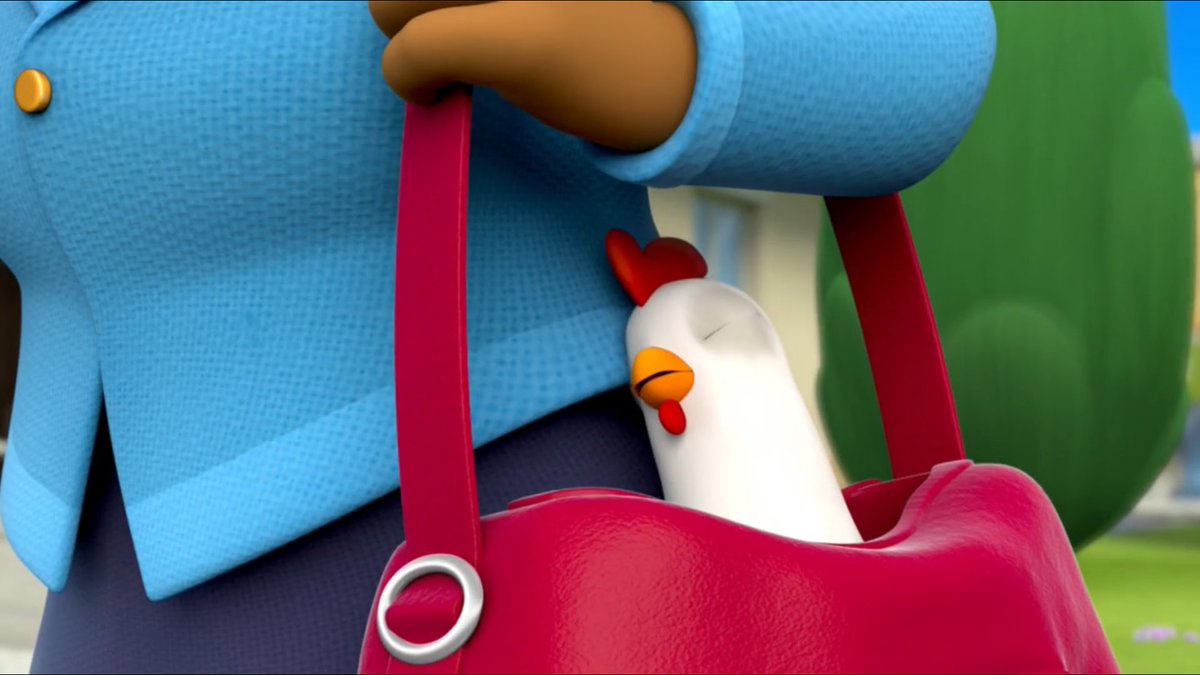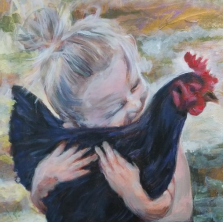In Europe and California, people actually know the difference between chicken myth and reality. There are places, however, where they do not, and there is a chicken mythology that has developed, due mainly to the Looney Toons. We in the Human Scale Living community find chickens to be interesting decor.

As part of the friendly service here at the Firefly, remarkable bed and breakfast near Madison GA, we are here to set the record straight.
Here are five myths about chickens, and the underlying reality.
Myth #1: Chicken Hawks are comically harmless
Perhaps you are thinking about this little chicken hawk. This poor bird is mainly a distraction for Foghorn Leghorn:
Reality: Chicken Hawks are a frequent danger.
We lost one of the more vulnerable members of the flock not too long ago, a half blind Barred Rock that barely survived the bird flu a couple of years ago.
Chicken hawks, a.k.a. the Red Tailed Hawk are common in Georgia, and one lives in the trees out in back. Chicken hawks are called that for a reason. According to this source:
An overachieving hawk can’t carry more than its own weight. The big white dog is safe for the moment.
Hawks
We’ll get a photo of the actual hawk at some point. Hawks, like all raptors, are protected by US Government:
We will leave aside the question of the current capability of the US government to protect anything, including itself. The Fish and Game department of GA is right up the road, however, and might conceivably try to protect this bird.
The reality of the chicken hawk is that it does not only eat chickens. These birds of prey also eat rats, mice, frogs, various crawling critters including snakes, and other smaller birds.
A hawk depends on its wings to survive. Any attempt to swoop down on something has in it an element of risk. A little breeze can cause a broken wing, which for these guys is fatal.
Hawks are also vulnerable to being pestered by crows, another of the common local birds:
So if you are a hawk, life is not as easy as you’d think. So even though we are annoyed that the fine for shooting one is serious, it’s better than having rats and snakes.
Myth #2: Dogs, Cats and Chickens can have a friendly rivalry.
Reality: Dogs and Cats are Carnivores
On your next trip to the supermarket, when the mood hits, walk through the pet food aisle, and see how many of the offerings are “chicken”.
This being the case, do you think that the mammals that live at the Firefly have ignored thousands of years of human-driven evolutionary history?
The Firefly is a pleasant enough place. But, it is still a farm, and these creatures are still animals. Accidents happen.
The dogs actually hate it when the chickens steal their food. The reality is, there is sort of a nervous coexistence between the chickens and the rest of the animals here. Here’s a video:
Myth #3, It’s OK to carry a chicken around in your purse.

The Viewers of this blog who know the Paw Patrol recognize Chickaletta. She rides around in the Mayor’s purse.
Reality: How much crap do chickens generate?
According to this source:
A chicken basically is a throughput machine. The average five pound chicken eats about a quarter pound of food per day. This comes from someone feeding it, or foraging.
That means they eat their own body weight in 40 days.
On average, they lay less than one egg per day. The rooster lays zero eggs per day.
This being the case, there is a constant mass balance of chicken crap being generated from our chickens, since they are real chickens. The Chicken Myth vs. Reality is that you have to know that.
Justin Rhodes, our role model on chickens, appreciates this source of free fertilizer. He has a system where he can move the chickens in a controlled way. This spreads the nutrients all over his little farm, keeps down the stink, and helps regenerate the land.
Chicken Reality: The Chicken Dilemma
We don’t really have chicken tractors like Justin. We have a well-built 720 square foot coop that mostly protects them from predators, and gives them an organized place to lay away from the dogs.

If they stay in there too much, they start to stink. If you let them out, the hawks get them, but they eat free. They do eat what they can find, and that includes bugs, and we don’t mind them eating bugs. In order to get a little free insect control, you have to put up with a little crap.
The commercial chicken farm out behind us collects their waste and uses it as fertilizer. They can do that because it is a bigger scale.
The prevailing management strategy is to coop them sometimes, and sometimes let them out because they get bored. So does the management.
Chickens in a Purse: Just Say No.
In the fictional Paw Patrol land, there are apparently no downsides to a chicken living in a purse. We know otherwise.
Side Point

There is one chicken that gets special treatment around here. If it is too cold, or too hot, a comfortable place is found for it.
It gets its picture painted from time to time.


In the case of this particular chicken, who is lame and picked on by the rest of the flock, some exceptions are made.
Myth #4: There’s a chicken in the oven.
Reality: If left alone, chickens are always exploring
If left to their own devices, a chicken will walk around, scratching. If they find a place that suits their needs, they will put it to good use.

Sometimes the chickens will choose an out of the way place to lay. When that happens it is time to lock them up again temporarily.
This natural curiosity occasionally gets them into the back of your vehicle. They are constantly in search of stale french fries. Therefore you might want to keep the doors shut.
Myth #5: They’re just one big happy family.
Here are a couple of videos, the second of which is now considered propaganda.
The idea here is that a flock of chickens is friendly enough to somehow be aligned to accomplish some higher level task.
Chicken Myth vs. Reality: The Pecking Order
This cannot be farther from the truth. If you care to observe them, which you can do from the semi-permanent chairs we have out there, you will see this. In fact, it is the local equivalent of the Real Housewives.
This little orange chicken gets picked on all the time, in fact. You can see that it has a bare spot on its back and no tail feathers.

For whatever reason, this pecking order phenomenon has not been bred out of our flock of chickens. Probably, because they are not industrial chickens, they are allowed to be chickens.
In the above article, it lays out some alternatives as to how a human can intervene in this whole thing. Justin Rhodes has a zero tolerance policy for overly aggressive chickens. Quite often they become food for some of the pasture pigs.
At the Firefly, the prevailing attitude is to feel sorry for the weakling, and paint its picture. That doesn’t necessarily solve the problem.

What to make of all of this?
Keep in mind when you are eating your lovely omelete this morning that there is an underlying system that provided it.
In the “normal” place, you are at the end of a very distant heavily industrialized process that “produced” your egg. Once in awhile one of these shows up at the Firefly.
In this “remarkable” place, there is also a system. It has gone on for a little while and is the opposite. The chickens, and eggs are 100 or fewer feet from the back door. There are a few problems that go along with this, but it is also part of the decor.
The chickens at this place are more about the feeling than the eggs. When they are allowed to serenely graze on the front lawn, they make it a farm, and connect it with another time when life was less complicated.
Even penned up, they’re mainly allowed to be chickens. Maybe you will notice the difference in either the egg quality, or the customer experience.
It is sometimes all about the experience.
![]()

We do love our chickens. Especially Weezy, the portrait model for our painted chicken. Also eggs are so much healthier than factory eggs, you wouldn’t believe it! Come to the Firefly and taste for yourself.